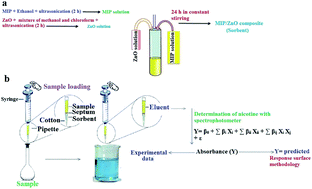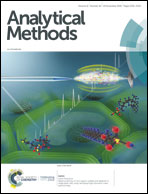Application of the response surface methodology in the optimization of modified molecularly imprinted polymer based pipette-tip micro-solid phase extraction for spectrophotometric determination of nicotine in seawater and human plasma†
Abstract
In this paper, a novel molecularly imprinted polymer/zinc oxide (MIP/ZnO) was synthesized and applied as an adsorbent for pipette-tip micro-solid phase extraction (MIP/ZnO PT-μSPE) of nicotine from seawater and human plasma followed by its spectrophotometric detection. Various factors affecting extraction efficiency, such as type and volume of eluent solvent, volume of sample, number of cycles of extraction and elution, pH, type and amount of sorbent and ionic strength of the sample solution, were investigated and optimized applying both the one-variable-at-a-time technique and response surface methodology (RSM). For RSM, experimental design was used with four parameters in three levels. Under optimum extraction conditions, the linear range for the analyte was 1–250 μg L−1 with a detection limit of 0.33 μg L−1. The method has been successfully utilized for the analysis of trace amounts of nicotine in seawater samples and human plasma.



 Please wait while we load your content...
Please wait while we load your content...